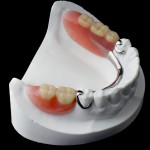
The concept of the shortened dental arch of 10 pairs of occluding anterior and premolar teeth is considered sufficient to provide good oral function and is supported by the WHO.
The aim of this study was to compare the impact of two different tooth replacement strategies for partially dentate older patients; namely functionally orientated treatment according to the principles of the shortened dental arch (SDA) and conventional treatment using removable partial dentures (RPDs) on oral health-related quality of life (OHRQoL)
Methods
Partially dentate older patients (>65 years) with a minimum of six remaining natural teeth in both arches of good prognosis and no medical contraindications to routine dental care were recruited. They were randomised to the RPD or SDA group.
All patients received dental care to render them dentally fit. Patients in the RPD group were restored to complete arches with RPDs using cobalt–chromium frameworks to replace missing teeth. Patients in the SDA group were restored to a premolar occlusion of 10 occluding pairs of natural and replacement teeth using resin bonded bridgework (RBB) throughout the arch. Posterior teeth distal to the SDA were left unopposed. All laboratory work was completed by the same lab an all-operative work by a single clinician.
OHRQoL was measured using the (Oral Health Impact Factor) OHIP-14 questionnaire at baseline, 1, 6 and 12 months. Systemic comorbidity was recorded using the modified Cumulative Illness Rating Scale (CIRS) at baseline,
Results
- 132 patients were randomised (65 to RPD group; 67 to SDA group).
- 89 patients (69.7%) complete the study. (44 in RPD group; 45 in SDA group).
- Treatment according to the SDA concept resulted in significantly better mean OHIP-14 scores compared with RPD treatment (p<0.05).
- This result was replicated in both treatment centres used in the study.
Conclusions
The authors concluded
This study illustrated that in terms of impact on OHRQoL, treatment based on the SDA concept achieved significantly better results than that based on RPDs 1 month, 6 months and 12 months after treatment intervention. Further research will be required to determine if these findings are maintained over a longer follow-up period particularly if maintenance of the restorations is required.
Commentary
The drop out in this well conducted study is almost 30%. Although the power calculation indicated that 44 patients were required in each arm to demonstrate that patients treated in the SDA group would be no worse off than those treated in the RPD group and over recruitment was planned. Reasons for dropouts are not provided. The findings demonstrated a significant improvement in OHRQoL in the SDA group. However other studies noted in the discussion including one study we discussed earlier this year (Dental Elf 13th May 2014) have not found significant differences between SDA and RPD. The authors themselves also recommend treating their results with caution at this stage and recommend longer follow up toinvestigate the impact of the survival of the different prostheses on OHRQoL.
Links
McKenna G, Allen PF, O’Mahony D, Cronin M, DaMata C, Woods N. The impact of rehabilitation using removable partial dentures and functionally orientated treatment on oral health-related quality of life: A randomised controlled clinical trial. J Dent. 2014 Jun 26. pii: S0300-5712(14)00188-2. doi: 10.1016/j.jdent.2014.06.006. [Epub ahead of print] PubMed PMID: 24973731.
Dental Elf- 15th Jul 2014 – Review suggests the shortened dental arch may be an acceptable approach

Don’t miss – Shortened dental arch: improved quality of life more than conventional treatment using partial dentures http://t.co/X57KB9ee8I
@TheDentalElf @Toothfairy4you klopt was me al bekend. Vaak zie ik overbehandeling #implantaten #frame…..verkorte tandboog kan prima werken
@mobielemondzorg Zeker. Het dient zichzelf vaak aan ook. #parodontitis @TheDentalElf
@Toothfairy4you @TheDentalElf klopt, echter zie ik dat menige klanten liever implantaatgedragen kronen willen tpv M1 en zelfs tpv M2….
[…] Dental Elf – 11th Dec 2014 – Shortened dental arch: trial suggests it improves quality of li… […]
[…] Dental Elf – 11th Dec 2014 – Shortened dental arch: trial suggests it improves quality o… […]